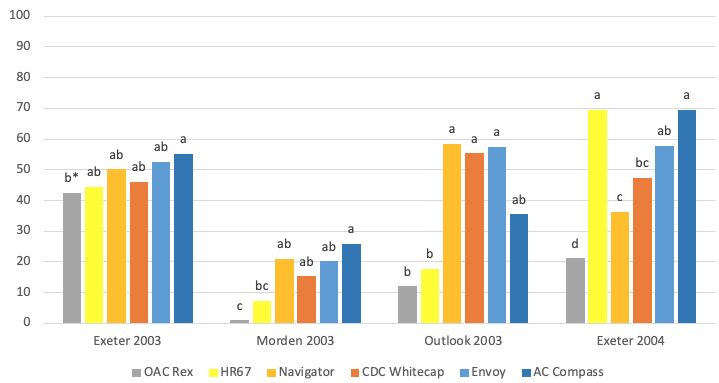Common bacterial blight (CBB) is a serious seed-borne disease of bean, affecting leaves, stems, pods and seed. Management includes disease free seed production and genetic resistance. The purpose of this study was to measure the effect of CBB resistant navy cultivars, under moderate/high disease pressure.
Two resistant and four susceptible cultivars were tested at six sites across Canada (Brooks AB, Outlook and Saskatoon SK, Morden MB, and Exeter and Elora ON). At each site, a non-inoculated study was managed to keep it disease free, while a separate study was inoculated with CBB. Each plot was isolated with a non-host crop to minimize cross infection. Leaf disease and yield were measured. A yield index was calculated for each cultivar, using the difference between non-inoculated and inoculated yield, divided by the non-inoculated yield. A yield index value near zero means a cultivar had similar non-inoculated and inoculated yields, which should denote genetic resistance.

Bars within a group (location and year) with the same letter are not significantly different (P<0.05).
Seven of 12 studies had moderate to severe CBB in the inoculated study, but almost zero infection in the non-inoculated study. There were no differences in early season plant vigour, plant height at flowering or seed weight at harvest (data not shown). Yield index differences for resistant and susceptible cultivars were evident at four sites (Figure 1). The resistant cultivars had a lower yield index, except for HR67 at Exeter 2004, which was stunted by a surfactant used during inoculum application. This resulted in a reduced yield for HR67 in the inoculated study, which in turn resulted in a high yield index. Over the seven studies with CBB infection, OAC Rex and HR67 had a mean yield advantage of 23.1 and 13.8%, compared to the four susceptible cultivars.
Originally published in Canadian Journal of Plant Science 2009. Volume 89. Pages 405-410. Revised July 2020 for drybeanagronomy.ca.
